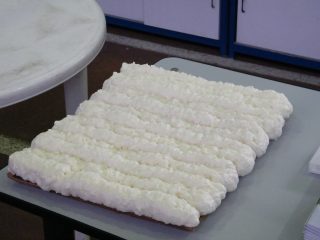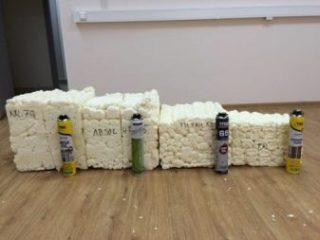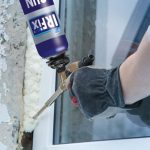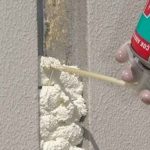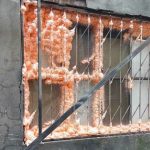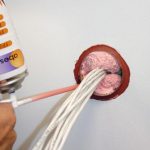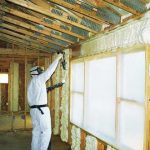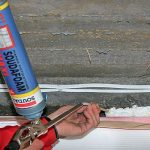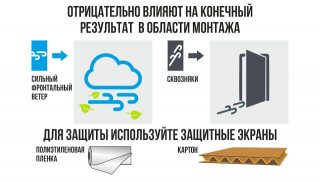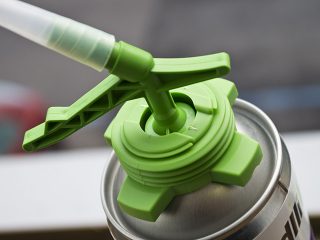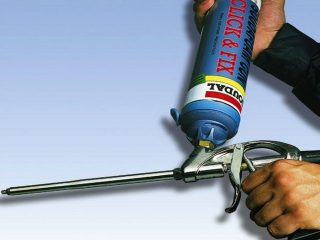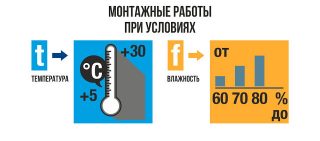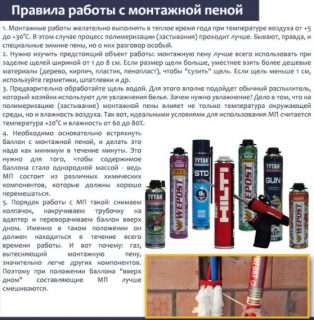Polyurethane foam is used in winter and summer, for this there are special frost-resistant and heat-resistant types. The composition is sold in cylinders that are equipped with a removable tube or valve for a pistol. When insulating surfaces and seams, the drying time of the polyurethane foam is taken into account, since the performance of subsequent work depends on the parameter.
- Description and characteristics of polyurethane foam
- Requirements
- Expansion ratio
- Main varieties
- Scope of application
- How much polyurethane foam dries
- Polymerization mechanism
- What affects the curing time
- How to speed up drying
- When can you cut
- Application rules
- At what temperature can you use
- How to apply correctly
- Consumption
- Recommendations
- Service life and storage of polyurethane foam
Description and characteristics of polyurethane foam
The substance consists of components:
- methylene diphenyl diisocyanate;
- polyols, which together with the first substance form polyurethanes;
- catalysts, stabilizers;
- foaming agents, antiseptics.
When solidified, the material acquires a light yellow color, but under the influence of the sun, the mass darkens, loses its plasticity, and becomes fragile. The foam layer is protected with a solution, sealant, paint.
Requirements

After drying the mass should shrink moderately, so that gaps do not turn out. Cheaper options lose volume after solidification.
Basic requirements for the insulator:
- High adhesion rates to surfaces, good adhesion of dissimilar materials. Foam should be combined with stone, brick, mortar, wood, plastic, porous blocks.
- Large expansion ratioto reduce the flow rate from the cylinder, but to obtain 100% filling of the gap. Foamed polyurethane foam expands over several hours.
Elasticity must be preserved in frost, cracks are unacceptable at subzero temperatures.
Expansion ratio
Expansion ratio depends on the following factors:
- ambient temperature;
- air humidity;
- the rate of exit from the balloon (using a tube or pistol).

Main varieties
According to the degree of readiness for work distinguish between one-component and two-component compositions. The first ones do not require mixing, they are only shaken in a cylinder. The second type includes two ingredients that are mixed before foaming.
By temperature of use:
- summer - used at a temperature of + 5 ° - + 35 ° C, but after solidification, the range expands;
- winter - it is possible to work at rates of -10 ° - + 40 ° С, at a negative temperature, the foam yield decreases;
- universal - combines the qualities of the winter and summer versions, gives a good volume even in frost.
There is a fire-fighting compound (B1), with self-extinguishing qualities (B2) and flammable (B3).
Scope of application
Foam is used as a fastening tool, for sound insulation, protection against heat loss, and sealing the gaps between the building structures of the house.
Application area polyurethane foam:
- filling gaps when installing doors, window frames, window sills;
- sealing joints between insulation plates when installing in an apartment, private house;
- foaming of seams between floor slabs when arranging a roof;
- gluing expanded polystyrene, foam plates on walls, ceiling, floor.
Waterproofing is glued with foam to the foundation, walls of basements, basements. Polyurethane foam is used in the construction of hoods, ventilation manifolds, heating systems.
How much polyurethane foam dries
The hardening period varies for each manufacturer within a small range. The manufacturer provides information on this on the packaging.
Approximate dates:
- setting of the universal foam occurs in 25 - 30 minutes;
- complete solidification occurs only after 24 hours.
Special substances are introduced into the material, which accelerate the opening of foam bubbles. Excess propellant and carbon dioxide are removed quickly, and the mass is a structure with a balanced number of closed and open cavities.
Polymerization mechanism
Before the time it leaves the balloon, the mass contains a liquid prepolymer dissolved with a gas propellant. The components of the latter substance are capable of boiling at low temperature and high vapor pressure. At the moment the mass leaves the container, the necessary conditions are created and the propellant boils, creating bubbles. The liquid prepolymer is converted to foam.
Description of the components:
- prepolymer - a substance obtained by the interaction of isocyanate MDI and hydroxyl polyalcohols;
- propellant - a gas mixture, partially dissolved in the prepolymer, partially in the form of a gas.

What affects the curing time
Humidity is also the cause of acceleration... In a bathroom where there is a lot of steam, the hardening will be faster. A similar increase in speed is observed in humid climates near the sea. Dry areas will slow down polymerization.
How to speed up drying
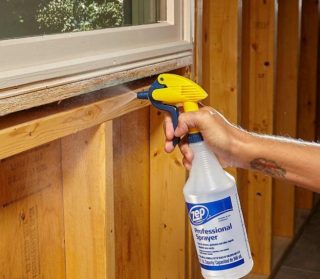
If the insulator is used at sub-zero temperatures or in a dry room, polymerization may take a long time. Experts advise to wait until it is completely dry before finishing.
The setting and hardening process can be accelerated:
- in frosty conditions, choose the foam intended for this;
- the laid foam is sprayed with water over the surface;
- trying to create an acceptable temperature in the room, close to ideal;
- before applying the composition, the surface of the seam is moistened with water using a brush or spray gun.
Approximate water consumption is 40 ml per 750 ml bottle.
When can you cut
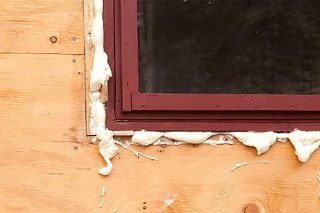
Experts do not advise cutting off excess foam ahead of time; it is better to wait if possible.Permanent mass expansion or shrinkage may occur, and therefore depressions or protrusions will appear. In fact, you can cut off the excess of a thin layer in 4 - 5 hours, but the more time elapsed after pouring, the better.
Subsequent expansion - this is the negative quality of the foam to change the volume after the end of polymerization. High-quality materials behave stably, such a process is not observed in them. For well-known manufacturers, the layer is an inert solidified mass, instability is not typical for it.
Shrinkage may appear due to insufficient density of the insulator due to an excess amount of ballast in the composition or open links inside. If the air temperature is increased after polymerization, the volume may increase due to the closed capsules inside. There is a bound gas that is displaced when heated.
Application rules
For household foam, removable tubes are used, which are sold with a cylinder. Professional formulations are applied with a pistol.
The first method is used for small amounts of work:
- sealing after installing the window;
- foaming the door frame during installation.
The second method contributes to the correct saturation of the outgoing foam with carbon dioxide, therefore increases the coefficient of expansion. The method is used in large facilities to achieve significant savings.
At what temperature can you use
It has been experimentally established that ideal conditions indoors are created with indicators:
- temperature + 20 ° С;
- relative humidity of the atmosphere 60 - 75%.
It is difficult to recreate such in detail, but in them the foam hardens completely in 4 - 5 hours.
How to apply correctly
Working rules:
- the nose of the tube is placed at an angle of 45 ° to provide a place for the polyurethane foam to exit and not block the view;
- for a short break in work, the cylinder is left in the pistol so that the mass does not dry out in the tube, valves;
- try to lead the seam evenly, without overlaying, without skipping sections, the nose of the tube is immersed in the foamed composition.
For foaming the surface of the walls, a wooden crate is made in the form of square cells to keep the layer on the surface until it dries.
Consumption
Correct counting will ensure that the right amount of material is purchased. From a standard 750 ml cylinder, 50 liters of insulator foam is obtained.
For example, to seal the gaps around the door frame, a thickness of about 5 cm is required. This is 300 ml or 30 liters of ready-made foam, for which one 750 ml cylinder is purchased.
From the practice of specialists, it follows that a standard cylinder is enough for foaming 1.5 doorways during installation. For three doors, two containers are counted.
Recommendations
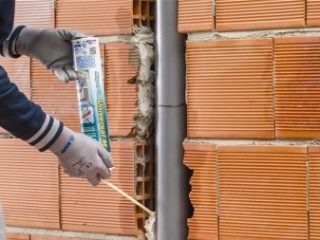
Handle the cylinders with care, they must not be dropped, hit, used near an open flame, or left in the open sun.
Other tips:
- when working, use gloves, glasses, wear a respirator in closed rooms;
- provide room ventilation;
- the stream of foam is led from the bottom up;
- at negative temperatures, it is impossible to soak the surface before applying;
- when the composition gets on adjacent surfaces, it is removed immediately, without waiting for solidification.
At the time of purchase, the supplier must provide a certificate to avoid hassles during work and subsequent finishing.
Service life and storage of polyurethane foam
Store polyurethane foam in cylinders at a temperature + 5 ° - + 35 ° С, frosty temperature and overheating are not allowed. Once inserted into the gun, the cylinder can be used within six monthsif not removed from the device. So the composition will always be ready for work, the working pressure will remain inside the gun.
After removal, the mixture dries up in the tube and pistol valves, so you need it right away rinse with special liquid.
The life of an unopened container is indicated on the packaging. Expired foam loses its declared qualities.

